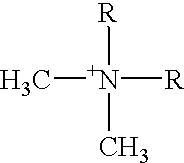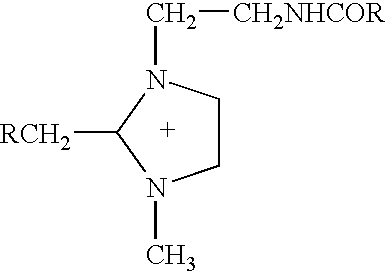Wet crepe throughdry process for making absorbent sheet and novel fibrous products
a technology of absorbent sheet and novel fibrous products, which is applied in the direction of press section, non-fibrous pulp addition, transportation and packaging, etc., can solve the problems of insufficient commercial success of wet crepe through-air dry process, high energy consumption of thermal dewatering with hot air,
- Summary
- Abstract
- Description
- Claims
- Application Information
AI Technical Summary
Benefits of technology
Problems solved by technology
Method used
Image
Examples
example 141
[0228] A web was produced as described in comparative Example P with the same fibers and furnish, except that the hoods were cooled down to reduce the dryness of the sheet at the creping blade. A nascent web was deposited on a pressing felt and pressed to a solids content of 44%, simultaneously with being adhered to a Yankee dryer. The web was creped from the Yankee dryer at a solids content of 55% and a blade bevel of 10.degree.. The web was subsequently pulled out using a pair of calender with rolls very lightly nipped with a resulting crepe of 15% left in the sheet. Percent crepe was calculated as:
(Yankee speed-Calender speed).div.Yankee speed.times.100%
[0229] The sheet was then collected and dried to a solids content of about 95% while held in restraint by sheet restraining / drying racks at room temperature. This restrained drying is used to the approximate as-creped properties of the sheet. Multiple fabric can drying could also be used but might not exhibit such a dramatic effec...
example 142
[0231] A web was produced as in Example 141, except that the creping was carried out using a 15.degree. bevel blade.
[0232] FIG. 9 is a photographic representation of the cross machine direction of a 35 lb web produced according to the present invention. The web was creped from the Yankee dryer with a 15.degree. beveled blade. As can be seen from the 50.times.photograph, delamination of the fibers occurs within the web, thereby increasing bulk and absorbency of the web.
example 143
[0233] A web was produced as in Example 141, except that the creping was carried out using a 0.degree. bevel blade.
[0234] The above examples establish that this process responds much like a normal dry creping process, but the low internal cohesion of the fibers in the web, due to its wetness, amplifies the creping effects.
[0235] It was quite surprising that the coating on the Yankee surface never changed throughout the above examples. Similar processes carried out on a cooler Yankee resulted in significant changes in the coating on the Yankee making the coating difficult to establish and to maintain.
[0236] In the process according to the present invention, the amount of wear observed on the creping blade was significantly reduced below that which one would expect from a wet crepe process. By way of illustrative example, crepe blades used in wet creping processes would often be worn out in as little as 30 minutes, while the creping blade in the process according to the present invent...
PUM
| Property | Measurement | Unit |
|---|---|---|
| Length | aaaaa | aaaaa |
| Fraction | aaaaa | aaaaa |
| Fraction | aaaaa | aaaaa |
Abstract
Description
Claims
Application Information
 Login to View More
Login to View More - R&D
- Intellectual Property
- Life Sciences
- Materials
- Tech Scout
- Unparalleled Data Quality
- Higher Quality Content
- 60% Fewer Hallucinations
Browse by: Latest US Patents, China's latest patents, Technical Efficacy Thesaurus, Application Domain, Technology Topic, Popular Technical Reports.
© 2025 PatSnap. All rights reserved.Legal|Privacy policy|Modern Slavery Act Transparency Statement|Sitemap|About US| Contact US: help@patsnap.com



